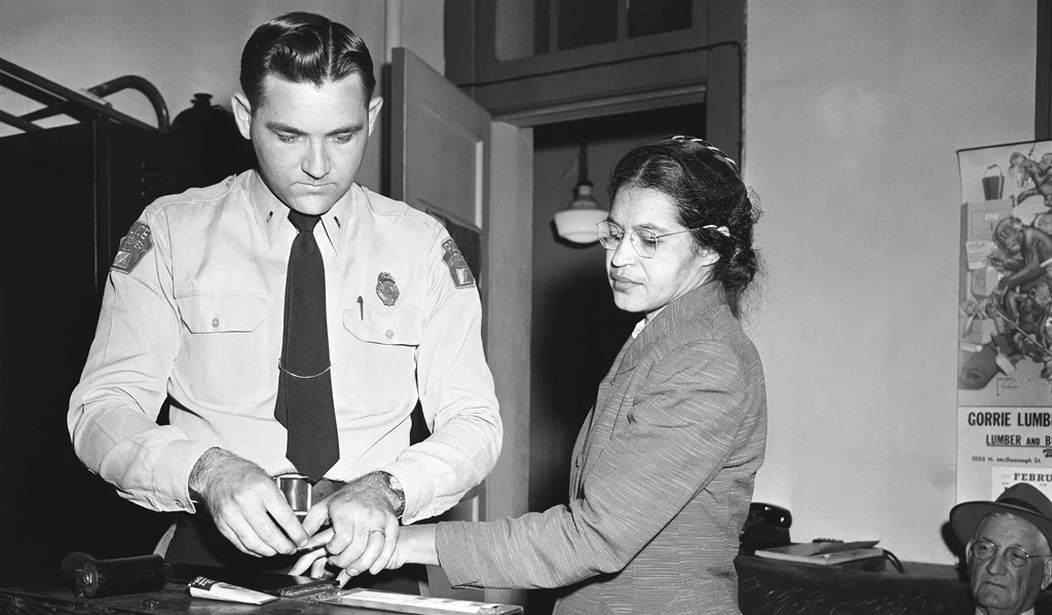This week, President Trump commemorated the courage of Rosa Parks, the Montgomery, Alabama seamstress who refused to give up her seat on a bus. In his latest address, the President expanded on the significance of her civil disobedience: “She defended the truth etched into our Declaration of Independence, that all of us, regardless of the color of our skin, are created equal by God.” Incidentally, both Trump and Parksreceived Ellis Island Awards in 1986 for their work helping inner city black youth.
I first learned about Rosa Parks in Second Grade. The actors dramatizing her story were black and white, but they interchanged the races of their roles by wearing a black or white scarf. It was an interesting interplay, demonstrating that the fight for civil rights belongs to everyone. In high school, I watched a one-woman show dramatizing that entire day. The actress played Rosa Parks’ coming home from work. She also played the racist bus driver telling her to give up her seat, then presented the aftermath of her arrest and the sensational fame that followed.
The basic details of that fateful day are well-known. December 1st, 1955, Parks was coming home from another long day at work. Alabama winters dip into the low 40s, so she took the bus. She was ready to get out of the cold and get home, as anyone would. Because of the racist Jim Crow laws, she sat down in the Colored Section of the bus after she bought her pass. Pretty soon, the entire “Whites Only” section filled up, yet more white passengers began boarding. The bus driver told Parks and three other black passengers to move to the back of the bus. While the others moved as ordered, she refused. Despite warnings from the bus driver that he would have her arrested, she said “No”. Police arrived, put her in handcuffs, and booked her. She was released on $100 bail.
Recommended
Recently, I learned more pertinent details of that day and why Rosa Parks’ simple act of defiance brought down the established racist social order.
Some people wrongly think that Parks was a lady just looking for a fight. In the past, Parks had grudgingly complied with Jim Crow laws, although one incident stuck out her in mind. In 1943, she paid her fare, then attempted to enter through the middle door outside, the common practice on segregated bus lines. Instead of waiting, the bus driver just drove off without her. She determined never to suffer that kind of outrage and humiliation, and further resolved to avoid that particular bus driver, James Blake. But without realizing it, her bus driver that day was the same bigoted bus driver who had left her stranded 12 years ago. There was no way that Blake would get away with dishonoring her a second time.
Many people believe that Parks decided on that December evening to resist the bus line’s Jim Crow ordinance. But, actually she had been waiting for the right moment to challenge the unjust law. In her own words, Parks was just “tired of giving in.”
What was she thinking about at that critical moment on the bus? What imposed on her specifically to stand firm and not give in? She thought of 14-yearold Emmett Till, the black boy brutally lynched earlier that year for whistling at a white woman. The bitter injustice of a young boy’s outrageous murder motivated her to take a stand.
Furthermore, Rosa Parks’ decision was not some “didn’t do nothing” act, for she suffered a great deal following her civil disobedience. She went to jail, faced a fine. Supporters filed a lawsuit on her behalf, which stalled in court. She would lose her job and receive death threats afterwards, even when she moved to Detroit. It cost her a great deal.
Another question arises: Many black activists before her had refused to give up their seats, yet nothing happened. Why was Parks’ refusal to give up her seat successful in fueling protest and ending the bus line segregation? Her actions captured the attention of the new, burgeoning national media, which repeatedly documented the excesses of liberal Democratic bigotry in the South. Because of her connections with fellow activists as the secretary of the Montgomery NAACP, outrage erupted immediately to organize a sustained and ultimately successful boycott.
What should we learn today from her fight against racism and government-sponsored bigotry? How all of us can fight back against a latent movement of resegregation on college campuses and liberal cities.
Charges of racism have turned into a militant excuse to shut down meaningful discussion on college campuses. Black activists have blocked white students from entering college dorms. A Professor Emeritus at UC Riverside chanted about “The Brown Race and the Brown Giant” taking over the United States. On the same campus, a Hispanic student stole a MAGA hat from a Trump supporter in the name of ending “genocide”. Whatever happened to “All men are created equal”? Racism is racism, no matter who perpetrates it or is victimized by it.
Let’s hope that Rosa Parks’ example will inspire people today to see everyone as created equal in the eyes of God. The fight for civil rights includes everyone. If necessary, more people will need to engage in civil disobedience, but always with the emphasis on“civil”.




















Join the conversation as a VIP Member